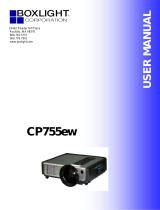Computer input
The computer input is suitable for both Apple Macintosh computers (Power Book and Power Mac) as
well as for IBM compatible PCs.The projector is Microsoft (R),Windows (R) 95/98/ME/2000/XP
compatible and accepts input signals from all computers that meet following specifications:
• Multi scan VGA-SXGA
• Horizontal scan rate: 15-108 kHz
• Vertical refresh rate: 50-120 Hz
• Bandwith: 140 MHz
• Display Data Channel DDC: 1/2B
Analog (VGA) connection
The data (VGA) output of IBM compatible PCs can be connected directly to the Data 2 input of the
projector using standard data cables.When connecting the projector to a Macintosh computer
equipped with a 2 row, 15 pin connector a VGA/MAC adaptor (available at your PC store) is required.
If your computer is equipped with a 3 row connector no adaptor is needed.
The Data 2 input socket accepts the input signal of the following formats: 480p, 720p, 1080i,
RGBHV and RGBSOG.
Digital (DVI) connection
The DVI input socket (Data 1) allows direct digital connection to your computer. Digital to
analog conversion by means of an adaptor is therefore no longer necessary and the computer is
automatically optimized to work with the projector, resulting in the highest possible picture
quality.The socket is also backward compatible with analog computers (via the DVI-I/VGA adapter
supplied) and accepts the input signal of the following formats: RGBHV (analog), RGBsog
(analog) and DVI (digital).
RS-232 connection
When RS-232 connection is used the projector can be operated via a RS-232 control system
and the projector status can be checked on the control system screen. See the RS-232 protocol
file (ProjectorMax) on the Cd-rom on how to include projector commands in an external
control system.
Universal Serial Bus (USB)
The Universal Serial Bus (USB) connector allows you to connect to computers equipped with a USB
interface, resulting in real hot plug and play presentation.
Mouse control:
By connecting USB, the mouse function on the Remote Control automatically gets installed.
You can now manipulate the mouse cursor on the computer and on the screen, using Cursor Control
on the remote control.The Mouse Left/Right keys on the remote control function as Left and Right
mouse keys of your pc.
Audio (only with bSure2 Brilliance version):
Audio information from the computer will be heard via the projector speaker.
Drag and drop facility:
Drag and drop via the remote control works slightly different than via the pc mouse. Here’s how:
• Use Cursor Control to select the item to be moved.
• Press and keep pressed Mouse Left.
• Use Cursor Control to move the selected item.Then release Mouse Left.
– The item will now be moved.
• Press Mouse Left when the item reaches the required location.
– The item will now be dropped.
Theft deterrence (PC only)
The SecurityMax™ application, supplied on the Cd-rom, allows you take a number of precautions
against unauthorized use of your projector. Once the application is installed, you can, for example, set
your own code protected personal start-up screen and shutdown timer which make theft unattractive
to any potential thief.You only need to run the Security Max™ software on the pc that is connected to
your projector via the Universal Serial Bus. For this feature see the ‘Security Max’ user guide on the
Cd-rom.
General information
4. Installation
Philips Multimedia Projector 15 English User guide cClear
>General information




















